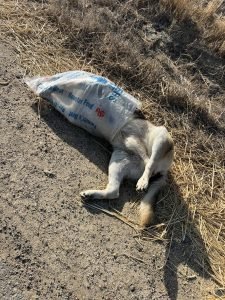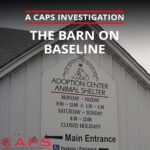
CAPS Spends Long Day in Kern County to Shoot Interviews and Footage
California’s municipal shelters are in crisis. Many of the animals live in overcrowded, inhumane conditions, without sufficient exercise or veterinary care. Euthanasia rates are shockingly high. In some parts of the state, backyard breeding is rampant, and spay/neuter services are woefully insufficient. The Central Valley overflows with abandoned dogs, living in fields and dying on roadsides, including dogs and puppies killed intentionally by cruel means.
Documentary on California’s municipal shelters
It is time for the California Legislature to take action. CAPS is making a critical new short documentary called The Crisis at California’s Municipal Shelters to push for much-needed legislation. California needs a law that requires the state to license, regulate, and inspect municipal shelters. As with a similar law in New York, the shelters would have three years to come into compliance with the help of state funding and training.
CAPS has started videotaping interviews and footage for this critical documentary. Kristopher Brant, a videographer with a master’s degree from the film school at Tisch School for the Arts at New York University, is generously donating his time to shoot the footage. Kris and his wife, Megan Greenfield, who found out about our planned documentary on social media and reached out to CAPS, are animal lovers who foster rescue dogs. CAPS’ video producer/filmmaker of 20 years will be producing the documentary.
On September 19, 2023, CAPS President Deborah Howard, Kris and Megan went to Kern County. The first stop was at Kern County Animal Services (KCAS) in Bakersfield, where 400 dogs live in two metal warehouses without outdoor access. The barking is nearly constant and can be heard outside the main building, reverberating against the metal. Chris shot video with his phone. CAPS has saved 210 dogs from this shelter since mid-February 2022 through social media, a Petfinder page, shelter to shelter/rescue transfers and other means.
Friends of Abandoned Dogs
Deborah, Kris and Megan then went out with Melissa, who is with Friends of Abandoned Dogs, a Kern County-based nonprofit. A team of about six women cover a 60-mile radius providing food, water and care for Kern County’s many abandoned dogs. They also try to rescue dogs when they have foster homes in place. Deborah interviewed Melissa while she left food and water for dogs and puppies at several locations. Most of these dogs are skittish and hard to catch.
Dog at the Lamont Library
The first stop after the shelter was in Lamont, a mainly agricultural town of around 15,000 people southeast of Bakersfield. Deborah, Kris and Megan met up with Melissa at the library, which is on the grounds of a park and shares a parking lot with the Kern County Career Services Center. Melissa set out food and water behind the library. Soon, a skittish black dog appeared near the career services center. He was reluctant to put weight on one of his front paws and would only allow people to get within a few feet of him. Melissa said that during the recent rains, the dog sat under the eaves of the library building. Melissa thinks the dog may have originally come from a neighborhood adjacent to the park and library.

Doberman mother and puppies at dilapidated house
Deborah, Kris and Megan then followed Melissa down country roads into the fields and pulled into a short dead-end dirt road. On the left side of the road was a very dilapidated house with a junk-filled yard; there was also a large amount of junk at the end of the road. Around the house was a six-foot wooden fence with a couple holes at the bottom under which a Doberman Pinscher mix mother and her puppies came out when Melissa started to put out food and water. Another puppy came running across the fields on the right of the road. She said that the mother had had two litters, with several puppies having been killed by cars. No one was taking care of these dogs.

A truck pulled up and a woman got out. She asked Melissa what she was doing. Melissa explained that she had been leaving out food and water for the dogs since no one appeared to be caring for them. The woman said she had just been released from prison after a one-year sentence and had 11 children ages 9 – 25 years old. She said that she lived in the house with another woman who has two small dogs and that a previous occupant of the house had left behind the Doberman and her puppies.

Chris and Melissa, who were in one car, followed by Deborah and Megan in another, noticed that the woman was following them to the next location. Melissa thought that the Doberman mother and puppies might belong to this woman, and that she hadn’t been able to care for them while in prison.
Eddie in the Fields
The last feeding and watering stop was for Eddie, a reddish shepherd mix who was dumped as a puppy. Melissa sat on the ground while he came up to her, but she was unsuccessful in putting a collar and leash on him. The FAD women had previously set up a large trap, but he got spooked and ran out of it. The following week, they set up an even bigger cage trap and successfully rescued him. Eddie is now living at a boarding facility while FAD looks for a foster home.

Dead Dogs
Dead dogs are along the sides of the roads, bordering the fields where food is grown. Residents of Kern County often throw their dogs from vehicles while stopped or moving. Driving from the location of the Doberman mix dogs to Eddie, Deborah and Megan witnessed the body of a black dog on the side of the road. It appeared that a car had hit the dog in the face.

Shortly before Deborah, Chris and Megan arrived in Bakersfield, Melissa had witnessed a horrible sight: a dog food bag with a dead dog, who appeared to have been murdered. (warning – graphic image). The body was left near a feeding and watering station. She was reluctant to look inside the bag because there was a huge pool of blood.
Dumping dog food bags with bodies of dogs and puppies is common. One time, the FAD women looked inside a dog food bag and found a mother and puppies all shot in the head. The dog food bag was still there two weeks later. Four weeks later, Melissa opened the bag: bones and pieces of fur were all that remained from being in the hot Kern County sun.
CAPS instructed the FAD women to call the sheriff’s dispatcher, request that they pick up the body to do a necropsy and examine the bag for evidence. The dispatcher said no one was available on the weekend, but that they would take away the body on Monday. Six weeks after being dumped, the body is still on the edge of almond fields. On October 26, the body of a decaying dog (warning – graphic image) in a children’s plastic wading pool became part of the same dumping area. It is possible this dog, which appears to be a German Shepherd, was drowned, yet the sheriff’s dispatcher told the FAD women to call animal control.
Lack of Cooperation from Kern County Sheriff’s Department
The FAD women told CAPS that the Kern County Sheriff’s Department won’t do anything about canine crime victims, and that animal control rarely picks up the bodies of those hit by cars. Animal control officers from Kern County Animal Services are too busy picking up live animals: abandoned dogs and injured cats, abandoned feline mothers with kittens, or motherless kittens. CAPS cannot stand by – just as we didn’t stand by once Deborah witnessed the conditions in which dogs live at Kern County Animal Services. Dogfighting and cockfighting (dead roosters in bags are also dumped) take place in Kern County. CAPS believes some of the dogs who are killed and placed in dog food bags were used for fighting.
CAPS is working with the Animal Welfare Data Center to develop an app the FAD women can use to document the date, time, and location of dogs who appear to be crime victims and to upload photos and videos. The Kern County Sheriff’s Department is under the supervision of the California Attorney General for civil rights and other violations, including not responding properly to citizen complaints. Kern County Sheriff Donny Youngblood has been with the department for 50 years and running it for 17 years.
Deborah has emailed District Attorney Cynthia Zimmer and Deputy District Attorney Jordan Houl, who is with Kern County’s Rural Crimes Unit. Neither one has responded to the email or voice messages. She requested that the sheriff’s department take crimes against animals seriously. People who engage in fighting animals are often involved with selling drugs and other crimes.
Interview with Dr. Eller
The last stop was at Bakersfield Animal Care Center, where Deborah interviewed Dr. Nicole Eller, the former veterinarian for Kern County Animal Services. Dr. Eller, whose areas of expertise include aviary and equine veterinary medicine, has impressive credentials: DVM from University of Minnesota; MS in Forensic Science from University of Florida; and former field veterinarian with ASPCA who investigated cruelty cases. She gave a very compelling interview about the inhumane conditions at the county shelter and why she chose to leave after less than seven months. At the end of the interview when Dr. Eller was describing the euthanasia room at Kern County Animal Services, she and Deborah began to cry.

Dr. Eller now works for Bakersfield Animal Care, the city shelter, three days a week and does spay/neuter work the other two days. CAPS is also working with the city shelter to coordinate the transport of dogs to shelters out of state. This shelter is much better run than the county shelter, with the dogs living in traditional indoor/outdoor enclosure. The shelter was quiet except when a person walked by the enclosures. Both the city and county shelters have high euthanasia rates.
How you can help
In mid-November, we will be shooting videos of interviews with volunteers, rescuers and adopters affiliated with other California municipal shelters. CAPS cannot make this documentary without your help. Our goal is to raise $10,000. Please donate generously today and make a difference in the lives of California’s unwanted animals.




